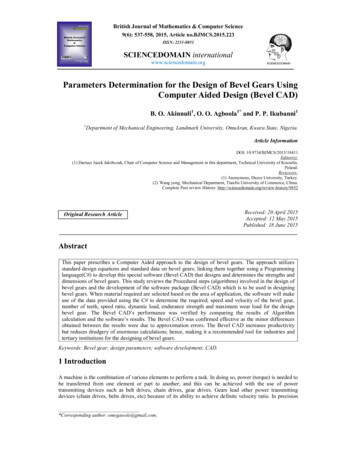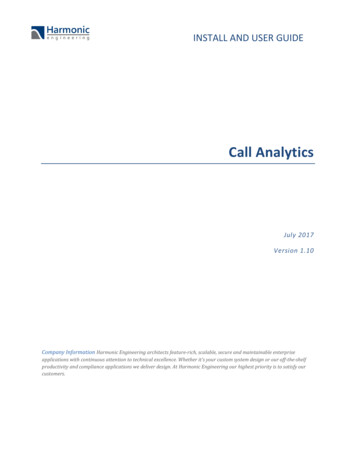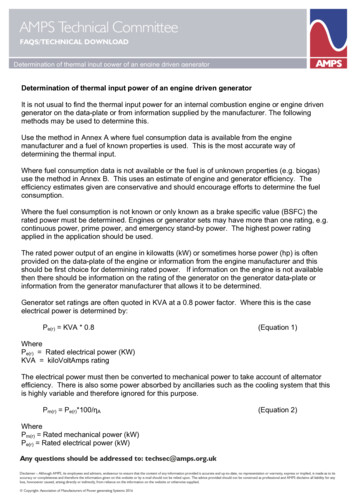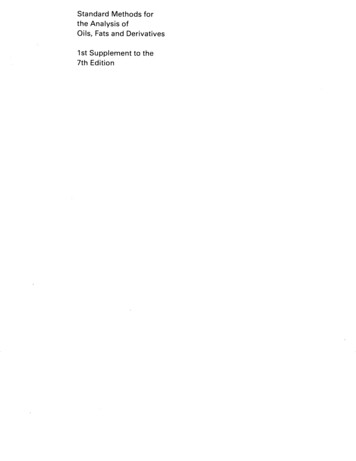
Transcription
British Journal of Mathematics & Computer Science9(6): 537-558, 2015, Article no.BJMCS.2015.223ISSN: 2231-0851SCIENCEDOMAIN internationalwww.sciencedomain.orgParameters Determination for the Design of Bevel Gears UsingComputer Aided Design (Bevel CAD)B. O. Akinnuli1, O. O. Agboola1* and P. P. Ikubanni11Department of Mechanical Engineering, Landmark University, OmuAran, Kwara State, Nigeria.Article InformationDOI: 10.9734/BJMCS/2015/18411Editor(s):(1) Dariusz Jacek Jakóbczak, Chair of Computer Science and Management in this department, Technical University of Koszalin,Poland.Reviewers:(1) Anonymous, Duzce University, Turkey.(2) Wang yong, Mechanical Department, TianJin University of Commerce, China.Complete Peer review History: al Research ArticleReceived: 20 April 2015Accepted: 12 May 2015Published: 18 June 2015AbstractThis paper prescribes a Computer Aided approach to the design of bevel gears. The approach utilizesstandard design equations and standard data on bevel gears; linking them together using a Programminglanguage(C#) to develop this special software (Bevel CAD) that designs and determines the strengths anddimensions of bevel gears. This study reviews the Procedural steps (algorithms) involved in the design ofbevel gears and the development of the software package (Bevel CAD) which is to be used in designingbevel gears. When material required are selected based on the area of application, the software will makeuse of the data provided using the C# to determine the required; speed and velocity of the bevel gear,number of teeth, speed ratio, dynamic load, endurance strength and maximum wear load for the designbevel gear. The Bevel CAD’s performance was verified by comparing the results of Algorithmcalculation and the software’s results. The Bevel CAD was confirmed effective as the minor differencesobtained between the results were due to approximation errors. The Bevel CAD increases productivitybut reduces drudgery of enormous calculations; hence, making it a recommended tool for industries andtertiary institutions for the designing of bevel gears.Keywords: Bevel gear; design parameters; software development; CAD.1 IntroductionA machine is the combination of various elements to perform a task. In doing so, power (torque) is needed tobe transferred from one element or part to another; and this can be achieved with the use of powertransmitting devices such as belt drives, chain drives, gear drives. Gears lead other power transmittingdevices (chain drives, belts drives, etc) because of its ability to achieve definite velocity ratio. In precision*Corresponding author: omegawole@gmail.com;
Akinnuli et al.; BJMCS, 9(6): 537-558, 2015; Article no.BJMCS.2015.223machines (clock), in which a definite velocity ratio is of importance, gears and other toothed wheels could beused.A gear is a rotating machine element having cut teeth (or cogs) which mesh with another toothed part inorder to transmit torque. Geared devices can change the speed, torque, and direction of a power source.According to [1], gear is one of the most important devices used in many types of machinery. Gears allowthe user to translate power, motion and torque. Gears have a power transmission efficiency of up to 98% andare some of the most durable torque transmitting machine elements.A bevel gear system is used for transmitting power at a constant velocity ratio between two shafts whoseaxes intersect at a certain angle. Gear can be used to transmit large power (small car can run on belt drivesbut large vehicles can’t, instead gears are being used). Gears are mostly applicable to small centre distancesof shafts; they possess high efficiencies; they have reliable services; gears have compact layout. Theseamong other characteristics of gears give it edge over other power transmitting devices. Bevel gears amongother gears are used for transferring torque with intersecting shafts in the same plane.While bevel-gear CAD software is a computer software that aids engineers, bevel-gear designers,manufacturers in the design of bevel gears. Since the World is turning towards computer technology and theuse of computer to alleviate human efforts; the application of computer to the engineering world is not leftbehind. Hence, numerous works has been done on Computer Aided Design. Gear as an important machinecomponent has also benefitted from this technological development. Works had also been done on geardesign software and improvements are being achieved on daily basis. Therefore, [2] stated that model designof the bevel and hypoid gear is an area of great research interest nowadays. Recently, modeling of spiralbevel and hypoid gear made a lot of achievement, summarized as: 1) Point-to- surface modeling by fittingdiscrete points on the tooth surface, during which the vital steps are the solution of the discrete points on thetooth surface and their obtainment based on derivation of the tooth surface equations. 2) line-to-surfacemodeling by fitting tooth profile curves, whose core areas are the equation derivations of the tooth profilecurves and the output in the three-dimensional graphics software [3].Computer Aided Design CAD was defined by [4] as any design activity that involves the use of computer tocreate, modify and document engineering design using interactive computer graphics systems referred to as aCAD system. Since its inception, CAD has undergone continuous development. [5] reported that by the1970’s, CAD systems were being used in many drafting application and by the mid-1970s, there was anestablished market for CAD. CAD has grown from a narrow activity and concept to a methodology ofdesign activities that include computer or group of computers used to assist in the analysis, development anddrawing of product components. One of the areas where CAD was employed in manufacturing technologyas related to gear design is the Gear skiving where CAD simulation approach was used [6].Also, CAD surface design can be used for rapid prototyping by sweeping or rotating, and creating the curvessurface from the point cloud, a variety of new modeling and their respective optimization methods wereexplored. This can then compensate for some deficiencies in the previous modelings, and create newconditions for fast and accurate parametric modeling of the spiral bevel and hypoid gear [7].2 Bevel Gear ReviewAs reported by [8], the first primitive gears can be traced back to over 3000 years ago where early gearswere made from wood. They were made of wood and had teeth of engaged pins. Early Greeks used metalgears with wedge shaped teeth; Romans used gears in their mills; stone gears were used in Sweden in theMiddle Ages (Gears Manufacturers). All of these cultures found reasons to use basic gearing to convertenergy or motion in one form to a form they could use in devices for the technological advancement of theirsocieties.Gears have existed since the invention of rotating machinery. However due to their force multiplyingproportions, early engineers used them for hoisting heavy loads such as building materials. The mechanical538
Akinnuli et al.; BJMCS, 9(6): 537-558, 2015; Article no.BJMCS.2015.223advantage of gears was also used for ship anchor hoist and catapults. Bevel gears are indispensable parts ofdrive systems found in power transmission for various machinery and equipment [9]. Due to a relativelycomplex geometry, continuous efforts are made to streamline the design and manufacturing process of bevelgears [10]. As a result of this, there is need for accurate modeling of spiral bevel which gives room fordigitized manufacturing such as the tooth contact analysis (TCA) technology, the error correction of toothsurface technology and other key technologies [11].According to [12], mating gear teeth acting against each other to produce rotary motion may be likened to acam and follower. As two gears mesh, there is tendency for unwanted noise to be generated. [13] claimedthat accurate tooth surface and good surface quality are critical to achieve the low-noise bevel gear drives.Bevel gear has the numerous applications in engineering and machine design. It has several importance andapplications. Among these applications are:2.1 The Differential DrivesThis can transmit power to two axles spinning at different speeds, such as those on a cornering automobile.The Fig. 1 below shows a typical example of a differential bevel gear.Fig. 1. Hypoid bevel gears in a car differentialSource: [14]2.2 Dividing HeadDividing head used machining operations like milling gears, sprockets on milling machine.2.3 Hand Drill MechanismHand drill mechanism as the handle of the drill is turned in a vertical direction, the bevel gears change therotation of the chuck to a horizontal rotation.2.4 Rotorcraft Drive SystemsSpiral bevel gear are important components on this system and are used to operate at high load and highspeed. In this application, spiral bevel gears are used to redirect the shaft from the horizontal gas turbineengine to the vertical rotor.539
Akinnuli et al.; BJMCS, 9(6): 537-558, 2015; Article no.BJMCS.2015.223Over the years, engineers have been coming out with various designs of bevel gears; trying to improve ontheir performances under various loads. This has assisted in the invention and production of machines withhigher performances and efficiencies.The bevel CAD software in discussion is a specialized software not meant for the designing of other gears ormachine part unlike other multi-purpose software such AUTOCAD, INVENTOR, CATIA, PRO E. Thesoftware is mainly for the design of bevel gears. Its specialization has made this software easier and moreflexible for bevel gear manufacturers and designers.This paper aims at identifying the designed parameters required in designing bevel gear, collect relevant datafor bevel gear design, develop algorithm for the steps required for the computation for each parameter,develop a software for implementing the algorithm developed and test the performance and effectiveness ofthe software model developed.The numerous applications of bevel gears in machines have made its design more frequent and important. Asa result of its immense importance, several works are being done on improving the efficiencies of bevelgears under static and dynamic load. This among other under-listed reasons justifies this research work:i.Time and efforts in designing Bevel gear can be far reduced by using the BEVEL CAD software inthe design. This will also assist designer focus on conception of ideas.ii. The modeled software is more flexible and user friendly; hence, making it comprehensive and easierfor designer to use.iii. The software uses standard data and formula from renowned Engineering Textbooks; thus, making itsresult more reliable.iv. The computational speed of the modeled software is comparatively better than other multipurposeCAD software such as INVENTOR, AUTOCAD etc3 Methodology3.1 Terminologies and Design Parameters IdentificationThe design of a bevel gear starts from getting acquainted with various terminologies, symbols/parametersand formulae attributed to Bevel gear. A bevel gear is shaped like a section of a cone. See Fig. 2.0 for thenomenclature of a meshed bevel gear.Fig. 2.0. Nomenclature of a meshed bevel gearSource: [15]540
Akinnuli et al.; BJMCS, 9(6): 537-558, 2015; Article no.BJMCS.2015.223The parameter/symbol used, description as well as the formula (as applicable) are tabulated as shown inTable 1.Table 1.0. Parameters/symbols, description and formula usedSymbol/Parameterσo1σo2T1 or T2Description/Meaning (unit)Allowable static stress of pinion wheel(N/mm2)Allowable static stress of gear wheel (N/mm2)N1 or N2GΘsθp1Number of Teeth in pinion and wheelrespectivelySpeed of pinion and gear respectively (rpm)Velocity ratio or input gear ratio (unitless)Shaft angle (o)Pitch angle for pinion wheel (o)θp2mPitch angle for gear wheel (o)Module (unitless)D1 or D2deDiameter of pinion and wheel respectively(mm)Dedendum (mm)aAddendum (mm)TdTooth depth (mm)rfFillet radius (mm)TthTooth thickness (mm)DR1 or DR2Root diameter of pinion and gear respectively(mm)Slant height of Pitch cone(mm)LFormulaTo be determined from thematerial usedTo be determined from thematerial usedOne of the two would be givenOne of the two would be givenTo be givenTo be given θp2 90o - θp1To be determined from theAGMA standard table for toothformmT1 and mT2 where m is themoduleTo be determined from theAGMA standard table for toothformTo be determined from theAGMA standard table for toothformTo be determined from theAGMA standard table for toothformTo be determined from theAGMA standard table for toothformTo be determined from theAGMA standard table for toothformD1 – 2de and D2 – 2de2V1 or 2 2Velocity of pinion or gear (m/s)600003.2 Gear Teeth SystemA tooth system is a standard given by the American Gear Manufacturers Association (AGMA) and theAmerican National Institute (ANSI). It specifies relationship between addendum, dedendum, working depth,tooth thickness and pressure angle to attain interchangeability of gears of a tooth number but of the samepressure angle and pitch. Gear designers should be informed of advantages and disadvantages of the various541
Akinnuli et al.; BJMCS, 9(6): 537-558, 2015; Article no.BJMCS.2015.223systems so that optimum tooth for a given design can be chosen. Basically there are four systems of gearteeth.iiiiiiiv14.5º Composite system14.5º full involute system20º full depth involute system20º stub involute systemTable 2.0. Standard proportion of gear system by AGMAS/N1.2.3.4.5.6.7.AddedumDedendumWorking depthMinimum total depthTooth thicknessMinimum clearanceFillet radius at root14.5º Compositeor full depthinvolute system1m2.25 m2m2.25 m1.5708 m0.25 m0.4 m20º full depthinvolute system20º stub involutesystem1m1.25 m2m2.25 m1.5708 m0.25 m0.4 m0.8 m1m1.6 m1.80 m1.5708 m0.20 m0.4 mSource: Khurmi and Gupta (2005), note: m in the Table 2.0 stands for module3.3 Lewis, Buckingham and Tregold FormulaThese equations are applied to determine the tooth form, Bevelling factor, Tooth form factor and staticstrength. Static strength of bevel gear is obtained by determining the following parameters.(a) Velocity factor CvVelocity factor Cv is determined first base on the level of cut of the gear.Cv (For a carefully cut gear)(1)Cv (For teeth cut by form cutter)(2)Cv (For teeth generated with precision machines)(3)where v is the velocity in m/s)(b) Equivalent Number of Teeth TEEquivalent number of teeth for both Pinion and Gear wheel are obtained from the relations shown belowrespectively.TE1 T1secθp1(4a)TE2 T2secθp2(4b)(c) Tooth form factor Y’Tooth form factor for pinion Y’1 0.154 .(5a)542
Akinnuli et al.; BJMCS, 9(6): 537-558, 2015; Article no.BJMCS.2015.223Tooth form factor for pinion Y’2 0.154 .(5b)(d) Bevel Factor B.FB.F 6; where b is the face width given as(e) Tangential Tooth Load WTTangential Load for pinion WT1 σo1 x CV x b mY’1 x B.F(7a)Tangential Load for gear WT2 σo2 x CV x b mY’2 x B.F(7b)where σo1 and σo2 are allowable static stress of pinion wheel and allowable static stress of gear wheelrespectively.Design condition: if WT1 WT2, it means that pinion teeth are weaker than gear teeth.3.4 Dynamic LoadDynamic load is mathematically expressed as the summation of incremental load due to dynamics andtangential tooth load i.eWD WI WTwhere WI (8)()but c is a deformation factor expressed as c (9).(10)where E1 and E2 are the modulus of elasticity for pinion and gear respectivelyDynamic load of pinion wheel WD1 WI1 WT1(11a)Dynamic load of gear wheel WD2 WI2 WT2(11b)(f) Endurance StrengthEndurance strength for pinion wheel Ws1 σE1b mY1’ x B.F(12a)Endurance strength for gear wheel Ws2 σE2b mY2’ x B.F(12b)where σE1 and σE2 are the endurance strength of the material used for pinion wear and gear wheelrespectively.(g) WearMaximum wear load of pinion wheel Ww1 (13a)Maximum wear load of gear wheel Ww2 (13b)543
Akinnuli et al.; BJMCS, 9(6): 537-558, 2015; Article no.BJMCS.2015.223but Ratio factor Q is given as Q Load stress factorwhere .((14) )(15a)is the surface endurance limit of pinion wheelLoad stress factorwhere .( )(15b)is the surface endurance limit of gear wheelDesign condition: If Ww1 WT1 & WW2 WT2 (design is satisfactory from the standpoint of wear).3.5 Algorithm for the Design of Bevel Gear1.Declare constants for different materials (using Table 1.0)o-Allowable static strengthAllowable endurance strengthes Allowable surface endurance strengthE- Young moduluse-2.Select Materials and Gear FormsI.II.III.IV.3.Dimension of Bevel elect materialsSelect tooth form(14.5 full depth involute, 20 full depth involute, 20 stub)Select level of cut- (first class cut, carefully cut, precision cutSelect forms of gear loading ( steady load, pulsating load, shock load)Select module from list of standard module moduleEnter the gear ratioEnter the number of teeth of the pinion gearEnter the ratio of slant height (l) of face width (b)Determine the face width (b)Determine the pitch angle (θp1) of the pinion θ tanDetermine the pitch angle(θp2) of gear θ θ θDetermine the number of teeth of the second wheel Determine the pitch diameter of gear (DG m X TG)Determine the pinion pitch diameter (DP m X TP)Determine the tooth depth (a d)Determine root diameter (Dp-2d)Determine the outside diameter (DP 2a)where G velocity ratio/ gear ratio. Speed and Velocityi.ii.iii.iv.Enter velocity of pinion wheel in rpmDetermine the velocity of the gear wheel (NP/G)Determine the pitch line velocity ‘v’ in m/sDetermine the velocity factor CV544
Akinnuli et al.; BJMCS, 9(6): 537-558, 2015; Article no.BJMCS.2015.2235.Gear Design using Tregolds, Buckingham & Lewis Formulasi.ii.iii.iv.v.6.Select the Allowable static stressDetermine the equivalent tooth form secDetermine the bevel factor. . Determine the tooth form factor(yˡ)Determine the static strength using lewis formula( WT (ϬO CV) bπmy yˡ B.F)Dynamic Loadi.Determine service factor CS Determine increased load due to dynamic forceii.7.21 ( )21 Determine the dynamic load (WD WT WI)Endurance Strength Wsi.Select the endurance strength of the material selected (Ϭe, table)ii.Determine the endurance strength ( 1.25 1.35 1.5ˡ Ϭ) Conditions for endurance strength if(Steady load)(Pulsating load)(Shock load)ℎELSEℎℎ8.Wear Resistance/ Surface Endurance StrengthI. Determine young modulus of the pinion material (table)II. Determine the surface endurance (Ϭes) from ( table)III. Determine the young modulus of gear ratio (table)IV. Determine the stress factor ϬV. Determine the limiting load for wear . If Ww Wt then, design is satisfactory from the standpoint of wear Else design is not satisfactory from thestandpoint of wear.3.6 Algorithm FlowchartThe Algorithm flow chart in Fig. 3.0 shows the stepwise procedures for the design of bevel gear using theBevel CAD.545
Akinnuli et al.; BJMCS, 9(6): 537-558, 2015; Article no.BJMCS.2015.223StartInpupt material constantsϬo- Allowable static static strengthϬe- Allowable endurance strengthϬes- Allowable surface endurancestrengthEYoung modulusi.ii.iii.iv.Select materialSelect tooth formSelect level of cutSelect Gear loadingi.ii.iii.iv.Material selectedTooth form selectedLevel of cut selectedGear loading selectedStop546
Akinnuli et al.; BJMCS, 9(6): 537-558, 2015; Article no.BJMCS.2015.223Start--Module (m) from standardsRatio of slant height to facewidthEnter number of pinion teeth (tp)Enter the slant height (l)Enter the gear ratio (G)Enter gear shaft angle (θp)If G 1YesError! Numberof G must be 1NoError! Minimumnumber ofteeth to avoidinterferenceIf TP YesNo-AGear ratioModule(m)Number of pinion teeth (tp)Ratio of face width to slant heightAddendum (a) and dedendum (de)-APitch angle of the pinionPitch angle of the gearNumber of Teeth of the gear wheelPitch diameter of GearPitch diameter of pinionRoot diameterClearanceOutside diameterStop547
Akinnuli et al.; BJMCS, 9(6): 537-558, 2015; Article no.BJMCS.2015.223StartInput velocity of pinion (in rpm)Process velocity of Gear wheel (rpm)Pitch line velocity (m/s)Velocity factor (CV)Display velocity of gear wheelPitch line velocityVelocity factorStopStartAllowable static stress (Ϭo)Velocity factor CvFace width (b)State tooth form factorˡ 0.124 .(14 Involute)ˡˡ. 0.175 0.154 .Bevel factor .Static strength(20 stub)(20 involute) (Ϭ )ˡ.Display value of static strengthStop548
Akinnuli et al.; BJMCS, 9(6): 537-558, 2015; Article no.BJMCS.2015.223Start Deformation factorYoung Modulus (E1 & E2)Load static factor (k)Equivalent No of teeth of pinionEquivalent no of teeth of gearwhelRatio factor Increment load on wheelsDynamic load () Increment load W IDynamic load W dStopStartEndurance limit (Ϭe)Dynamic load stress factor (kd)Θ, B.F, YˡMaximum static load (W s ϬDesign is notsatisfactory fromthe standpoint ofdynamicsNoˡYesIF WS W I. )Design issatisfactory fromthe standpoint ofdynamicsDisplay value ofendurance strength (Ws)Stop549
Akinnuli et al.; BJMCS, 9(6): 537-558, 2015; Article no.BJMCS.2015.223StartPrepare pitch angle θFace width (b)Ratio factor (Q)Load stress factorProcess maximum wear load Design is notsatisfactory fromthe standpoint ofwearYesNoIf W W WTDesign issatisfactoryfrom the standpoint of WearDisplay value of maximumwear load of the wheels(W W)StopFig. 3.0. Algorithm flow chats3.7 Software DevelopmentThe algorithm above was used to develop the software (Bevel CAD) used in the design of bevel gear. Thiswas made possible by transforming the required formulas and data of bevel into a set of instruction codes.The codes written could validate the user inputs and respond by giving the user the necessary information.The software was designed using C# programming language and the Net Platform. The .Net Platform is anew and efficient platform from Microsoft cooperation that is invented to fill in the deficiency gap createdby its predecessor platform like Win 32, MFC, Visual Basic, to name but few.3.7.1 Reasons for using net platformThe .Net is preferred over other platforms due to the following reasons:1.2.3.It is neutral language. Numerous languages can be employed to write programs on this platform.There are over 250 programming languages presently available. Microsoft created four out of this.They are C#, VB. Net, J#, C /CLI).The platform is fully object oriented and this accounts for its unmatched ability in managing theautomation of the most complex problems.It is very secure. Security is planted at the core (most inner section) of the platform.550
Akinnuli et al.; BJMCS, 9(6): 537-558, 2015; Article no.BJMCS.2015.223Concerning its features, C# inherited 70% of java, 5% of VB, 10% of C/C , and it adds 15% new. Theprograms emulated good aspects of the suspect and became better software. This among other reasons lendscredence for the selection C# for designing Bevel CAD Designer.3.8 Main WindowThe Bevel CAD main window as shown in Fig. 4.0 consists of four tabs as listed and described below:i.ii.iii.iv.Material /Gear typeDimensionsSpeed and velocityGear designFig. 4.0. Bevel CAD main window3.9 Material/Gear Type InterfaceThe environment shown in Fig. 5.0 pops-up and request for the gear and the pinion and input information(parameter).The parameter requested for include the following:iMaterial- the material required include: cast iron of different grades, carbon steel, cast steel,aluminium steel, phosphor, bronze, alloy steel etc.ii Select tooth form- the various types of tooth forms which include : 20 stub, 20 involute, 14.5 involuteiii Level of cut- the accuracy of cut can be selected which include the following : precision cut, ordinarycut, carefully cutiv Gear loading- this software makes available margins for the type of loading that the gear will besubjected. The gear loading types include pulsating load, steady load and shock load.551
Akinnuli et al.; BJMCS, 9(6): 537-558, 2015; Article no.BJMCS.2015.223Fig. 5.0. Material/gear type environment3.9 Dimension WindowThe dimension window shows the interface of the inputs in the dimensions. The window is as shown inFig. 6.0.Fig. 6.0. Bevel CAD dimension interfaceThe software requires for the following input dimensions which include.552
Akinnuli et al.; BJMCS, 9(6): 537-558, 2015; Article no.BJMCS.2015.223iRatio of the face-width to the slant height: The slant height ratio to face-width value is demandedfor. Examples of these values are (l/2, l/2.3,l/2.5, l/3, l/4).ii Velocity Ratio: Also known as the Gear Ratio is also an input parameter in the design of the bevelgeariii Number of Pinion Teeth: The software request for the number of the initiated pinion gear.iv Enter the value of the module: The module value is also required for the design of bevel gear.v Shaft angle: The software is capable of processing any form of bevel gear of different shaft angles of90º, angular bevel gears (120 , 130 , 125 , 140 etc.).Clicking on the tab ‘get value for dimension’ the computer does the calculations in the algorithm anddisplays value for the following parameter. Pitch angle of pinion, pitch angle of gear, Number of pinionTeeth, Number of Gear teeth, diameter of gear teeth, diameter of pinion teeth, value of fillet radius, toothdepth, value of addendum, value of dedendum, root diameter of pinion, root diameter of gear, etc.There are 2 other tabs in this window, making it the 3 tabs in this window. Clicking the tab “return to thestart window” takes the designer back to the start window. Clicking the tab” Move to Next Window” popsup the “speed and velocity window”.3.10 Speed and Velocity WindowThe window requires just the velocity of the pinion in rpm. The computer itself generates velocity of thegear wheel in rpm and the pitch line velocity of the pair of gears. The window also has ‘move to the Nextwindow’ which takes the designer to the last phase called the ‘gear design window’. Snap shot of the speedand velocity interface is shown in the Fig. 7.0.Fig. 7.0. Gear speed and velocity interface3.11 Gear Design WindowThis window is the main citadel of the software. The phase does not require for any input but uses theexisting input to calculate and display the following gear characteristics.553
Akinnuli et al.; BJMCS, 9(6): 537-558, 2015; Article m strength of pinion ToothBeam strength of Gear toothDeformation factorIncrement load of pinion wheelDynamic load of pinion wheelDynamic load of Gear wheelEndurance Strength of pinion wheelEndurance Strength of Gear wheelMaximum Wear load of pinion wheelMaximum wear load of gear wheelLoad stress factor for pinion wheelLoad stress factor for gear wheelRatio FactorA snapshot of this window is shown in Fig. 8.0.Fig. 8.0. The gear design windowThe outstanding characteristics about this software is its ability to suggest to designer the conditions of thegear been designed in term ofiStronger teeth among the pinion and the gearii Endurance characteristic of the teeth under dynamics.iii Wear characteristic of the gear teeth under dynamic load.Fig. 9.0 is a snapshot of condition suggested after a test designed using the Bevel CAD.554
Akinnuli et al.; BJMCS, 9(6): 537-558, 2015; Article no.BJMCS.2015.223Fig. 9.0. Design condition snap-shot4 Results and DiscussionThe software was tested by comparing its result with the manually computed result using the same examples.The software found an excellently close answer with that of the result obtained from the textbook and thealgorithm test above. The software was again tested with other inputs from renowned textbooks andsimilar/close answers were also gotten. The little differences in the answers were due to errors due toapproximation. See Table 3.0 for the results of the manually computed results and Bevel CAD results.4.1 Design of Bevel GearMaterial used for both Pinion and Gear wheel Cast iron grey, Carefully cut with stead loading. Velocityratio/gear ratio 1.25, module 5 mm, Number of teeth in the Pinion wheel 16, Angle of shaft 90º,Speed of pinion wheel 1100 rpm.Table 3.0. Comparism between the resultsS/nParameters1234567891011Pinion pitch angleGear pitch angleNumber of gear teethDiameter of pinion wheelDiameter of gear wheelFillet radiusFace widthTotal depthAddendumDedendumRoot diameter of pinionValue from manual/handcomputation38.66o51.34o2080 mm100 mm2 mm21.34 mm11.25 mm5 mm6.25 mm67.5 mmValues from bevelCAD software39o51o2080 mm100 mm2 mm21.34 mm11.25 mm5 mm6.25 mm67.5 mm555
Akinnuli et al.; BJMCS, 9(6): 537-558, 2015; Article no.BJMCS.2015.223Table 3.0 continued .12Root diameter of gear13Slant height14Tooth thickness15Velocity of gear16Pitch line velocity17Beam strength of piniontooth18Beam strength of gear tooth19Deformation factor20Incremental load of pinionwheel21Incremental load of gearwheel22Dynamic load of pinionwheel23Dynamic load of gear wheel24Endurance strength of pinionwheel25Endurance strength of pinionwheel26Maximum wear load ofpinion wheel27Maximum wear load of gearwheel87.5 mm64.037.854 mm880 rpm4.61m/s796.9N87.5 mm64.037.854 mm880 6293.05N6208.09NComparing the manually calculated results with the CAD result, the following inferences are made:4.2 Accuracy in CalculationsVery close results were generated by both the manual calculation and that of the CAD software. Themodeled calculation is believed to be more accurate because it uses uniform approximation in all its results.4.2.1 Reduction in errors and time savingsIn addition to the accuracy of the software, errors and mistakes in computations were drastically reduced.Care must be taken in the calculations as the designers are proned to mistake
Computer Aided Design CAD was defined by [4] as any design activity that involves the use of computer to create, modify and document engineering design using interactive computer graphics systems referred to as a CAD system. Since its inception, CAD has u










